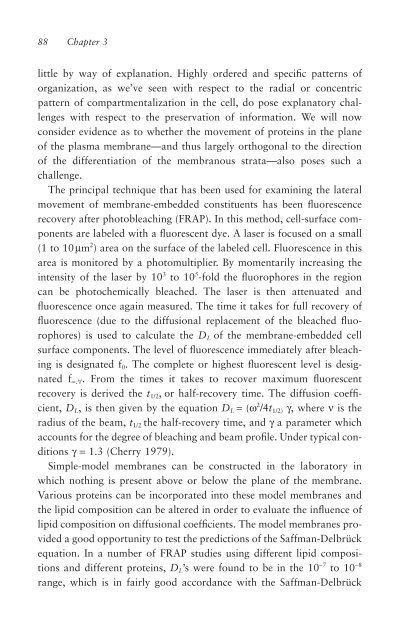A Critique of Pure (Genetic) Information
A Critique of Pure (Genetic) Information
A Critique of Pure (Genetic) Information
Create successful ePaper yourself
Turn your PDF publications into a flip-book with our unique Google optimized e-Paper software.
88 Chapter 3<br />
little by way <strong>of</strong> explanation. Highly ordered and specific patterns <strong>of</strong><br />
organization, as we’ve seen with respect to the radial or concentric<br />
pattern <strong>of</strong> compartmentalization in the cell, do pose explanatory challenges<br />
with respect to the preservation <strong>of</strong> information. We will now<br />
consider evidence as to whether the movement <strong>of</strong> proteins in the plane<br />
<strong>of</strong> the plasma membrane—and thus largely orthogonal to the direction<br />
<strong>of</strong> the differentiation <strong>of</strong> the membranous strata—also poses such a<br />
challenge.<br />
The principal technique that has been used for examining the lateral<br />
movement <strong>of</strong> membrane-embedded constituents has been fluorescence<br />
recovery after photobleaching (FRAP). In this method, cell-surface components<br />
are labeled with a fluorescent dye. A laser is focused on a small<br />
(1 to 10mm 2 ) area on the surface <strong>of</strong> the labeled cell. Fluorescence in this<br />
area is monitored by a photomultiplier. By momentarily increasing the<br />
intensity <strong>of</strong> the laser by 10 3 to 10 5 -fold the fluorophores in the region<br />
can be photochemically bleached. The laser is then attenuated and<br />
fluorescence once again measured. The time it takes for full recovery <strong>of</strong><br />
fluorescence (due to the diffusional replacement <strong>of</strong> the bleached fluorophores)<br />
is used to calculate the D L <strong>of</strong> the membrane-embedded cell<br />
surface components. The level <strong>of</strong> fluorescence immediately after bleaching<br />
is designated f 0. The complete or highest fluorescent level is designated<br />
f µ.". From the times it takes to recover maximum fluorescent<br />
recovery is derived the t 1/2, or half-recovery time. The diffusion coefficient,<br />
DL, is then given by the equation D L = (w 2 /4t 1/2) g, where n is the<br />
radius <strong>of</strong> the beam, t 1/2 the half-recovery time, and g a parameter which<br />
accounts for the degree <strong>of</strong> bleaching and beam pr<strong>of</strong>ile. Under typical conditions<br />
g=1.3 (Cherry 1979).<br />
Simple-model membranes can be constructed in the laboratory in<br />
which nothing is present above or below the plane <strong>of</strong> the membrane.<br />
Various proteins can be incorporated into these model membranes and<br />
the lipid composition can be altered in order to evaluate the influence <strong>of</strong><br />
lipid composition on diffusional coefficients. The model membranes provided<br />
a good opportunity to test the predictions <strong>of</strong> the Saffman-Delbrück<br />
equation. In a number <strong>of</strong> FRAP studies using different lipid compositions<br />
and different proteins, D L’s were found to be in the 10 -7 to 10 -8<br />
range, which is in fairly good accordance with the Saffman-Delbrück
















